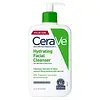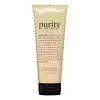What's inside
What's inside
 Key Ingredients
Key Ingredients

No key ingredients
 Benefits
Benefits

 Concerns
Concerns

 Ingredients Side-by-side
Ingredients Side-by-side

Water
Skin ConditioningGlycerin
HumectantCetearyl Alcohol
EmollientPEG-40 Stearate
EmulsifyingStearyl Alcohol
EmollientPotassium Phosphate
BufferingCeramide NP
Skin ConditioningCeramide AP
Skin ConditioningCeramide EOP
Skin ConditioningCarbomer
Emulsion StabilisingGlyceryl Stearate
EmollientBehentrimonium Methosulfate
Sodium Lauroyl Lactylate
EmulsifyingSodium Hyaluronate
HumectantCholesterol
EmollientPhenoxyethanol
PreservativeDisodium EDTA
Dipotassium Phosphate
BufferingTocopherol
AntioxidantPhytosphingosine
Skin ConditioningXanthan Gum
EmulsifyingCetyl Alcohol
EmollientPolysorbate 20
EmulsifyingEthylhexylglycerin
Skin ConditioningWater, Glycerin, Cetearyl Alcohol, PEG-40 Stearate, Stearyl Alcohol, Potassium Phosphate, Ceramide NP, Ceramide AP, Ceramide EOP, Carbomer, Glyceryl Stearate, Behentrimonium Methosulfate, Sodium Lauroyl Lactylate, Sodium Hyaluronate, Cholesterol, Phenoxyethanol, Disodium EDTA, Dipotassium Phosphate, Tocopherol, Phytosphingosine, Xanthan Gum, Cetyl Alcohol, Polysorbate 20, Ethylhexylglycerin
Water
Skin ConditioningSodium Trideceth Sulfate
CleansingDisodium Lauroamphodiacetate
CleansingAcrylates Copolymer
Polysorbate 20
EmulsifyingSodium C14-16 Olefin Sulfonate
CleansingGlycerin
HumectantCocamidopropyl Betaine
CleansingIsopropyl Alcohol
SolventSodium Sulfate
Limnanthes Alba Seed Oil
Skin ConditioningAniba Rosaeodora Wood Oil
AstringentPelargonium Graveolens Flower Oil
MaskingBulnesia Sarmientoi Wood Oil
MaskingCymbopogon Martini Oil
MaskingRosa Centifolia Flower Oil
MaskingAmyris Balsamifera Bark Oil
MaskingSantalum Album Oil
MaskingSalvia Sclarea Oil
MaskingOrmenis Multicaulis Oil
MaskingAcacia Dealbata Flower/Stem Extract
Skin ConditioningDaucus Carota Sativa Seed Oil
EmollientPiper Nigrum Fruit Oil
MaskingDisteareth-75 Ipdi
Glycereth-7 Caprylate/Caprate
EmulsifyingPotassium Chloride
Hydrogen Peroxide
AntimicrobialMagnesium Nitrate
Magnesium Chloride
Sodium Benzotriazolyl Butylphenol Sulfonate
UV AbsorberButeth-3
SolventTributyl Citrate
SolventSodium Hydroxide
BufferingSodium Chloride
MaskingDisodium EDTA
Citric Acid
BufferingLinalool
PerfumingMethylchloroisothiazolinone
PreservativeMethylisothiazolinone
PreservativeWater, Sodium Trideceth Sulfate, Disodium Lauroamphodiacetate, Acrylates Copolymer, Polysorbate 20, Sodium C14-16 Olefin Sulfonate, Glycerin, Cocamidopropyl Betaine, Isopropyl Alcohol, Sodium Sulfate, Limnanthes Alba Seed Oil, Aniba Rosaeodora Wood Oil, Pelargonium Graveolens Flower Oil, Bulnesia Sarmientoi Wood Oil, Cymbopogon Martini Oil, Rosa Centifolia Flower Oil, Amyris Balsamifera Bark Oil, Santalum Album Oil, Salvia Sclarea Oil, Ormenis Multicaulis Oil, Acacia Dealbata Flower/Stem Extract, Daucus Carota Sativa Seed Oil, Piper Nigrum Fruit Oil, Disteareth-75 Ipdi, Glycereth-7 Caprylate/Caprate, Potassium Chloride, Hydrogen Peroxide, Magnesium Nitrate, Magnesium Chloride, Sodium Benzotriazolyl Butylphenol Sulfonate, Buteth-3, Tributyl Citrate, Sodium Hydroxide, Sodium Chloride, Disodium EDTA, Citric Acid, Linalool, Methylchloroisothiazolinone, Methylisothiazolinone
 Reviews
Reviews

Ingredients Explained
These ingredients are found in both products.
Ingredients higher up in an ingredient list are typically present in a larger amount.
Disodium EDTA plays a role in making products more stable by aiding other preservatives.
It is a chelating agent, meaning it neutralizes metal ions that may be found in a product.
Disodium EDTA is a salt of edetic acid and is found to be safe in cosmetic ingredients.
Learn more about Disodium EDTAGlycerin is already naturally found in your skin. It helps moisturize and protect your skin.
A study from 2016 found glycerin to be more effective as a humectant than AHAs and hyaluronic acid.
As a humectant, it helps the skin stay hydrated by pulling moisture to your skin. The low molecular weight of glycerin allows it to pull moisture into the deeper layers of your skin.
Hydrated skin improves your skin barrier; Your skin barrier helps protect against irritants and bacteria.
Glycerin has also been found to have antimicrobial and antiviral properties. Due to these properties, glycerin is often used in wound and burn treatments.
In cosmetics, glycerin is usually derived from plants such as soybean or palm. However, it can also be sourced from animals, such as tallow or animal fat.
This ingredient is organic, colorless, odorless, and non-toxic.
Glycerin is the name for this ingredient in American English. British English uses Glycerol/Glycerine.
Learn more about GlycerinPolysorbate 20 is made by combining ethoxylation of sorbitan, ethylene oxide, and lauric acid. It is a mild cleansing agent, surfactant, and emulsifier.
As a surfactant, it helps collect dirt and oils for washing. Emulsifiers prevent oils and water from separating.
Polysorbate 20 also adds scent to a product. Since it is made using sorbitol, it has a sweet scent. Sorbitol can also be found in fruits such as apples and peaches.
The lauric acid used to create Polysorbate 20 is often derived from coconuts.
Polysorbate 20 may not be fungal acne safe.
Learn more about Polysorbate 20Water. It's the most common cosmetic ingredient of all. You'll usually see it at the top of ingredient lists, meaning that it makes up the largest part of the product.
So why is it so popular? Water most often acts as a solvent - this means that it helps dissolve other ingredients into the formulation.
You'll also recognize water as that liquid we all need to stay alive. If you see this, drink a glass of water. Stay hydrated!
Learn more about Water